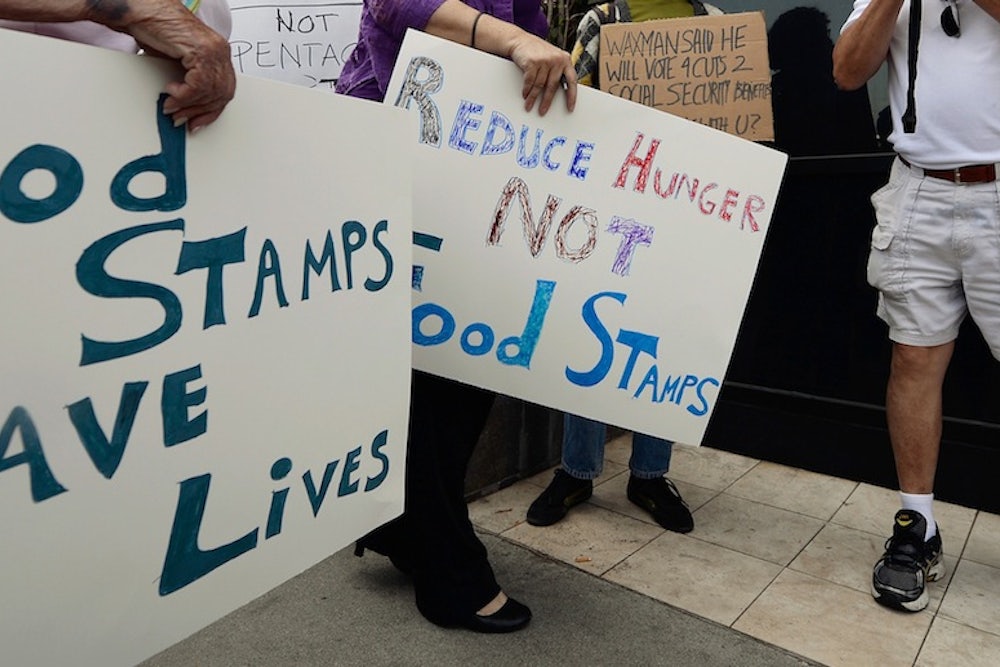When it passed a bill to cut $39 billion from the food stamp program, or SNAP, the House of Representatives put the worst of the Republican party’s illogical Randism on display. Perhaps the most telling statement came from Michael Grimm of New York, one of just 15 Republicans who didn’t vote for the legislation (which no Democrats supported); trying to excuse his failure to vote for what has been dubbed “one of the most heartless bills” in memory, he said:
"I just felt the cuts were a little too steep, especially because right now I have a lot of Sandy victims who have never been on assistance ever in their life," Grimm said. "And a lot of these hard-working families have lost everything, and for the first time, they're needing food stamps. So I didn’t want to affect those Sandy victims."
Those Sandy victims, who aren’t like the rest of America’s unwashed and untrustworthy poor (the bill requires drug testing for SNAP recipients, following a state-level trend that heaps stigma onto welfare), but who were knocked down through no fault of their own. Implied in what Grimm didn’t say is an excellent articulation of Republican beliefs about poverty and the people who find themselves in it, which were encapsulated in Mitt Romney’s 47 percent slip-up last year. At least, in a world governed by these rules, Grimm’s unlucky constituents will soon be back on their feet; it’s in the nature of cream to rise.
If you listened to Republicans say their piece in the House yesterday, you’d think the people suffering at the bottom our economy were there by choice. In the words of John Boehner, “This bill makes getting Americans back to work a priority again for our nation’s welfare programs.” If he’d done his homework, he’d know Americans are working: SNAP benefits decline far less than other government assistance programs as income rises, so the incentive to work is high—higher still given that the baseline SNAP benefit is only about $1.40 per person per meal. According to the Center on Budget and Policy Priorities, “Among SNAP households with at least one working-age, non-disabled adult, more than half work while receiving SNAP—and more than 80 percent work in the year prior to or the year after receiving SNAP.” So when the bill’s authors decided to mandate that adults between 18 and 50 without children who are minors find a job or apply to a work-training program before they could get a dime, and then limited the time those recipients could get benefits to three months in a three-year cycle, it’s not clear who they were trying to galvanize off the couch.
Under the House plan, the Congressional Budget Office (CBO) estimates that 4 million people would lose their food stamps next year, plus approximately 3 million people in years after that. Meanwhile, as my colleague Jonathan Cohn has written, SNAP “seems awfully good at what it is supposed to do: keep low-income people from going hungry or struggling even more financially”:
In 2011, according to the [Center on Budget and Policy Priority’s] analysis, "SNAP kept about 4.7 million people out of poverty in 2011, including about 2.1 million children. SNAP also lifted 1.5 million children out of deep poverty (defined as 50 percent of the poverty line) in 2011, more than any other government assistance program." Research by Kathryn Edin from Harvard and Luke Shaefer at the University of Michigan, two of the country’s leading scholars of poverty, has found that SNAP alone significantly reduces the number of households with children living on $2 a day. And new research from Shaefer, collaborating with Italo Gutierrez, suggests that SNAP significantly reduces the likelihood that low-income families will fall behind on other expenses, like rent and utilities.
And the Republicans’ hard, derisive line on these small handouts is thrown into high relief by the other half of the farm bill, from which SNAP has been severed, is a multi-billion dollar barrel of porkfat for massive agribusinesses. According to the U.S. Public Interest Research Group, in the last decade, “74 percent of these subsidies went to just 4 percent of agribusinesses, with more than 60 percent of farms not even getting a dime.” Most of the money goes toward farmers who grow corn, soy, and other products that are converted into junk food. Of the $277 billion spent on agricultural subsidies since 1995, the Colorado arm of U.S. PIRG calculated that “$18 billion went to various forms of junk food ingredients, ranging from corn syrup to vegetable oils and shortening.”
The ag giants aren’t the only ones living large. At yesterday’s House vote, Representative Jackie Speier of California waved a cooked steak, a bottle of vodka, and a can of caviar under her colleagues’ noses to remind them how much the government spends on their overseas excursions. “In my district, California 14, we have about 4,000 families who are on food stamps, but some of my colleagues have thousands and thousands more,” she said. “Yet, they somehow feel like crusaders, like heroes when they vote to cut food stamps. Some of these same members travel to foreign countries under the guise of official business. They dine at lavish restaurants, eating steak, vodka and even caviar. They receive money to do this. That’s right, they don’t pay out of pocket for these meals… One member was given $127.41 a day for food on his trip to Argentina. He probably had a fair amount of steak.” As for the 4.7 million SNAP kept out of poverty each year, they are and will remain the 47 percent.
Nora Caplan-Bricker is an assistant editor at The New Republic. Follow her on Twitter @NCaplanBricker.
